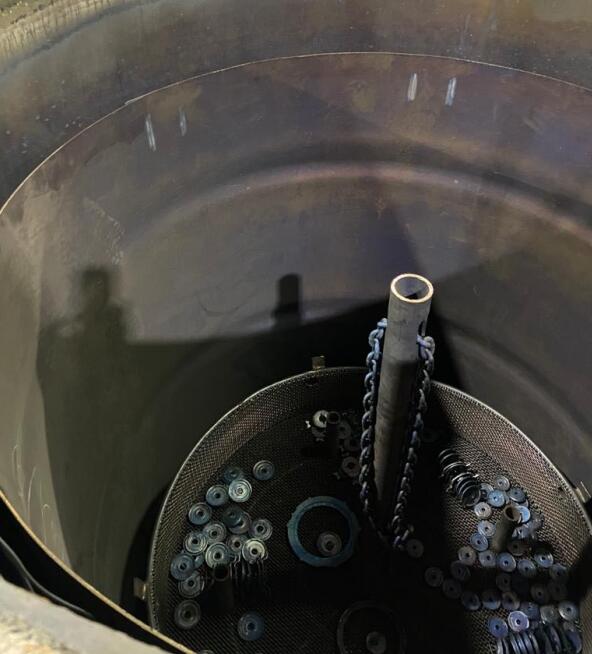Several Matters Needing Attention In Gas Nitriding Process
Ordinary gas nitriding is a surface strengthening process widely used in mechanical manufacturing, but the cycle is long, the operation is complex, and the nitriding quality is not stable.Therefore, how to stabilize the process, shorten the production cycle, reduce the injection brittleness must control the process parameters of the production process.
1. Heating method
Stepped heating is used.Because ordinary box or pit type furnace under 500 ~ 600 ℃ heat up quickly, if uncontrolled nitriding parts with the furnace, the furnace temperature is generally about 2 ~ 5 h can rise to the nitriding temperature, then the workpiece temperature and furnace temperature yet there is a difference, the greater the workpiece cross-section or furnace charging quantity, the more the greater the difference between them, so it is difficult to accurately calculate the nitriding time.The stepwise temperature rise method can significantly reduce the temperature difference between the furnace temperature and the workpiece ,It can also reduce the deformation of the workpiece with complex shape.The step-heating specification is determined by the size of the workpiece, the amount of furnace loading and the complexity of the shape of the workpiece. Generally, 20~40min keep insualtion for each 50-100 ℃ rise.
2.Ammonia decomposition rate
Ammonia gas into nitriding furnace must be dried before, commonly used desiccant anhydrous calcium chloride, silica gel, quicklime and so on.From the water absorption effect, anhydrous calcium chloride is the best. Desiccant must have enough volume, mainly according to the amount of ammonia by experience.
The decomposition rate of ammonia gas is usually controlled in a wide range in practical operation.Table (1) below shows the commonly used control range of decomposition rate at different temperatures, and Table (2) shows the influence of ammonia decomposition rate on the depth and hardness of permeable layer.
Table (1) Influence of ammonia decomposition rate on infiltration layer depth
| Nitriding temperature(℃) | Nitriding decomposition rate of a section(%) | Nitriding decomposition rate of a section(%) |
| 510 | 18~35 | 18~25 |
| 530 | 25~45 | 30~40 |
| 550 | 35~55 | 35~55 |
Table (2) Influence of ammonia decomposition rate on hardness
| Ammonia decomposition rate (%) | Nitriding thickness layer/mm | Surface hardness(HV) |
| 20 | 0.60 | 850 |
| 40 | 0.60 | 915 |
| 60 | 0.60 | 1000 |
| 80 | 0.58 | 850 |
In order to reduce the brittleness of seepage layer, easy to operate, save ammonia (510 degrees centigrade nitriding, decomposition rate from 30 to 50, ammonia consumption can be reduced by 25), ammonia decomposition rate as much as possible.
3.Cooling method
Most nitrided workpiece is through ammonia with the furnace slow cooling to 150~200℃, the average cooling rate of this cooling method is about 15~25℃/h, so the cooling time is very long, even dozens of hours, it is generally believed that slow cooling makes nitrided layer brittleness increase, in addition to slow cooling also reduce the corrosion resistance of the workpiece.Therefore, in order to shorten the nitriding cycle, improve the nitriding layer performance, nitriding after fast cooling is appropriate, and can even be furnace oil cooling.In order to reduce deformation, it is appropriate to control the average cooling rate between 50 ℃ and 80℃/h.The nitriding tank is moved out of the furnace or is cooled by compressed air between the nitriding tank and the heating body.For the workpiece with complex shape and strict deformation requirements, the nitriding tank can be moved to the outer air for cooling after the furnace is cooled to 400-500℃.
4.Loading capacity
It is reasonable to calculate 1/2~1/3 of the theoretical loading capacity according to the effective size of the furnace pot and the mode of loading.
Editing by Francis Lee
Copyright: RQ Furnace

Silicon Steel Sheet Drying Furnace Effect Of Magnetic Field Annealing On Structure And Properties Of Soft Magnetic Materials Research Progress On Annealing Process Of Amorphous Nanocrystalline Soft Magnetic Alloys

Contact us
Your email address will not be published. Required fields are marked *